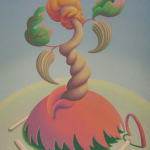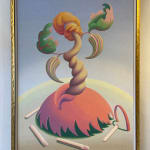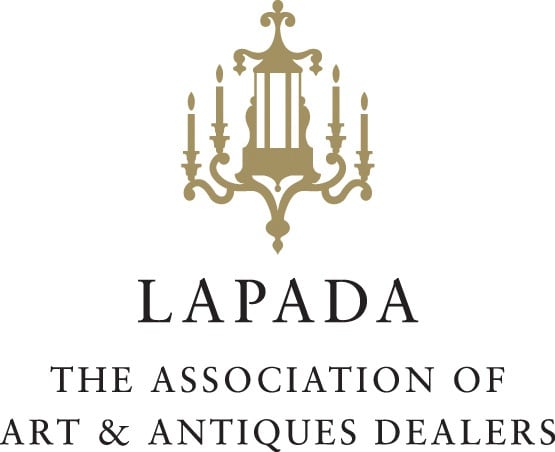Henry Orlik b. 1947
With artist's stamp verso
Framed H. 133.5 cm. x W. 98 cm., H. 52.5 in. x W. 38½ in.
Further images
Grabowski, as with many of Orlik’s paintings, carries many meanings and interpretations. It is an energetic painting in which Orlik depicts a beautifully coloured ‘plant’ growing out of a red pot which also resembles a joyful, dancing figure. The main stalk of the plant is flesh-coloured and twisted and resembles a clutching hand, folded inwards with one digit raised upwards on which, at its pinnacle, is a bright orange, bulbous bundle tied around with a colourful ribbon – the ‘head’ of the dancer - like a gaudy flower. Colourful buds, striped pink, yellow and green, shaped like chilis, are waiting to burst into flower; growing from the same red stem are two bright green leaves edged with pink, with red veins. The silhouetted edges of the leaves are shaped like human cut-out figures who appear to dance, arms raised upwards. The plant grows out of a red-orange mound which is also an upturned bowl or teacup with a jagged bottom (as if smashed and broken) and beneath which is a green shadow, like the underskirts of a jaunty skirt; the top (upturned base of the cup) is distorted into a spout to allow the stem to break through; by the side of the base is the curved, semi-circular ‘handle’ of the cup, which stands on its two feet making an arch; it is ‘completed’ by its green shadow so that it forms a heart. On the ground, around the plant lie four wooden, old-fashioned clothes-pegs – a memory from childhood, perhaps, when such pegs were ‘dressed up’ with scraps of cloth to represent people.
The exuberance of the colours and the energy of the movement of the dancing figure suggest the joy and marvel of creation. It becomes the dance of creation itself, Shiva appearing as Natarāja, the Lord of the Dance, who dances the cosmos into renewal. The leaves and buds are the four arms of the god dancing. And perhaps the plant also represents the Tree of Life, from which all colourful and diverse life metaphorically grows. The stalk-hand is holding ‘infinity in the palm of’ its hand and ‘Heaven’ is in the ‘Wild Flower’ (‘To see a World in a Grain of Sand/ And a Heaven in a Wild Flower/ Hold Infinity in the palm of your hand/And Eternity in an hour’, William Blake, Auguries of Innocence).
The bundle is a motif that Orlik used in his painting Parachute, in which the parachute drops a bundle onto a herd of deer who panic and stampede. Perhaps the bundle is the inspirational creative idea, not yet comprehended by the masses who are not ready for the message contained within. It could be the birth of the creative spark, the imagination which ‘is the real and eternal world of which this vegetable universe is but a faint shadow’ (William Blake). Here the imagination evolves from creation – it comes from the evolution of the mind – of consciousness knowing itself - and with ‘psychic energy’ increases with ‘the complexity of organised units’ which are the ‘atomic character’ of the universe (Pierre Teilhard de Chardin, The Phenomenom of Man, 1972, p. 45).
Shiva is Lord of creation and destruction and in the cycle of life you cannot have one without the other – without birth there is no death and without death there is no birth. Thus, both creation and destruction are represented in Grabowski. The red-orange bundle is also the red/orange mushroom cloud produced by a nuclear explosion and the broken teacup then becomes a representation of a teacup found at Hiroshima after the explosion (there is one in the Imperial War Museum in Manchester) and the heart, therefore, of the teacup handle and its shadow, is a broken heart. The base of the teacup has melted forward, dripping into a spout-shape and the ‘plant’ grows out of this – out of the domestic scene (the teacup and wooden clothes pegs) that has been shattered. The clothes-pegs represent the dead and the cut-out people on the leaves represent (the dance of) regeneration and re-birth.
The dual meaning (creation and destruction) are significant for Orlik’s interest in Quantum Entanglement, in which one constituent cannot be fully described without considering the other. It also suggests that particles live on and are eternal – have always been and will always be in whatever form of quantum or matter they become, so that we live ‘under the guise of eternity’ (‘sub specie aeternitatis’, Spinoza).
The title of the painting, Grabowski, relates to Mateusz Grabowski (1904-1976) who was a Polish-British pharmacist, art collector and philanthropist who owned the Grabowski Gallery in Chelsea. Grabowski was born in Poland, became a Master of Pharmacy and the government inspector of pharmacies. With war looming in the late 1930s, he became a member of the Polish Army Medical Corps, and subsequently organised the pharmacy services of the army. During World War II, he escaped from Poland, seeking refuge first in France and after its fall in 1940, in Britain. His family were left behind in Warsaw where his older son, Wojciech, participated in the Warsaw Uprising. Although they survived the war, his wife died in the aftermath and Grabowski was able to bring his two young sons to join him in London.
After the war, Grabowski set up a network of pharmacies in Earl’s Court (where many Poles lived, including Orlik in the early 1970s) and Chelsea and started one of the first mail order chemists in England. This enabled Polish and other resettled Central Europeans in Britain to send pharmaceutical products to war-ravaged Poland and other countries under Soviet occupation where there were persistent shortages of medicine and many everyday goods. People who had been in Fairford Camp with Orlik remembered how their parents could send medicines to their families in Poland which they could use or barter.
In 1959, Grabowski opened the Grabowski Gallery next to his chemist shop in Sloane Avenue. It was a non-commercial venture and he often mounted exhibitions in exchange for an artwork from an impoverished artist. One of the galleries earliest shows was a group exhibition of established Polish artists and it specialised in promoting young and diaspora artists. It hosted some of the earliest shows of the rising Pop Art and Op Art movements and launched the careers of some of Britain’s and the Commonwealth’s leading artists. Pauline Boty (1938-1966) staged her first solo exhibition in the gallery in the autumn of 1963. The gallery showed work by Maggi Hambling, David Hockney, Bridget Riley and Frank Bowling early in their careers.
The gallery was one of several noted contemporary art galleries set-up by émigré Poles in London. Another was Halima Nałęcz's Drian Galleries in Bayswater where Orlik exhibited in the early 1970s. Although it has not yet been established, it seems likely that Orlik knew and would have exhibited at the Grabowski Gallery at the same time as he was then exhibiting at the Acoris Centre and other London galleries. The gallery held its final show in 1975 and Grabowski died the following year.
The M. B. Grabowski Foundation endowed Polish Migration and Polish Cultural History studies at University College London, the University of Stirling, the University of Cambridge and Trinity College, Oxford. Grabowski donated his pharmaceutical and art collections to several museums in Poland including the National Museum in Warsaw, the Art Museum in Łódź, to which he donated 400 paintings, and the Pharmaceutical Museum in Krakow, which he supported with an extremely valuable collection of medicinal vessels from the 16th and 17th centuries.
After his father’s death, Wojtek Grabowski continued to manage the pharmacy chain and promote Polish culture in “Grabowski Gallery II”. His daughter, Marewa is married to the Greek prime minister, Kyriakos Mitsotakis.
Join our mailing list
Be the first to hear about our upcoming exhibitions, events and news
* denotes required fields
We will process the personal data you have supplied to communicate with you in accordance with our Privacy Policy. You can unsubscribe or change your preferences at any time by clicking the link in our emails.












